Tornado Watch vs Warning: What’s the Difference?
Did you know that about 1,000 to 1,200 tornadoes hit the U.S. each year? Most happen between April and June. It’s crucial to know the difference between a tornado watch and a warning to stay safe during bad weather.
A tornado watch means conditions are right for tornadoes in your area. It tells you to stay ready and alert. On the other hand, a tornado warning means a tornado has been seen or found on radar. You need to act fast.
Understanding these differences helps keep you and your family safe when severe weather hits.
Key Takeaways
- A tornado watch indicates potential tornado formation; stay alert.
- A tornado warning means a tornado has been spotted; take immediate action.
- Tornado watches cover larger areas, while warnings focus on smaller regions.
- Approximately 13 minutes is the average lead time for tornado warnings.
- Tornado emergencies represent the highest level of alert for severe threats.
- Knowing the difference can save lives and protect property.
Understanding Tornado Alerts
Tornado alerts are crucial for staying safe during severe weather. The National Weather Service (NWS) issues these alerts. They warn of tornadoes and other severe weather. Knowing the types of alerts helps you prepare better.
There are three main alert types: tornado watches, warnings, and emergencies. A watch means conditions are right for tornadoes. It’s a chance to act early and save lives.
Tornado warnings are for smaller areas, like a city. They mean a tornado has been spotted or detected. It’s time to act fast and follow safety tips.
A tornado emergency is for areas with many people. It means there’s a big risk of damage. The Storm Prediction Center and local offices issue these alerts. Keeping up with them helps you stay safe.
By watching for severe weather alerts and following safety tips, you can protect yourself. This knowledge is key to staying safe during a tornado.
The Importance of Severe Weather Alerts
Severe weather alerts are key to keeping people safe. When NOAA issues a severe weather alert, communities get crucial info. This info helps them get ready for dangers like tornadoes and severe storms. Knowing about these alerts lets you act fast, which can save lives.
Alerts have different levels of urgency. A tornado watch means conditions are right for a tornado. A tornado warning means one has been spotted or seen on radar. This info is essential for getting ready and responding to severe weather.
Emergency weather alerts cover more than just tornadoes. For example, severe thunderstorm watches warn of possible storms. Warnings mean storms are happening now. Flood watches and warnings warn of flooding, showing the need for quick action.
During Severe Weather Awareness Week in Michigan, from March 17 to March 23, people are urged to learn about these alerts. Knowing what to expect can greatly improve your safety during severe weather.
| Alert Type | Description | Action Needed |
|---|---|---|
| Tornado Watch | Conditions are favorable for tornado formation. | Stay alert and be prepared to take action. |
| Tornado Warning | A tornado has been spotted or detected by radar. | Seek shelter immediately. |
| Severe Thunderstorm Watch | Severe thunderstorms are possible. | Monitor updates and be prepared. |
| Severe Thunderstorm Warning | Severe thunderstorms are occurring or imminent. | Take shelter and stay safe. |
| Flash Flood Watch | Conditions are favorable for flash flooding. | Stay informed and be ready to move. |
| Flash Flood Warning | Flash flooding is imminent or occurring. | Seek higher ground immediately. |

Tornado Watch vs Warning: What’s the Difference?
Knowing the difference between a tornado watch and warning is key to staying safe. A watch means conditions are right for tornadoes to form. You should stay ready because a tornado could happen. Watches cover big areas, like whole states or counties.
A tornado warning is much more serious. It’s issued when a tornado is seen or found on radar. This means you’re in danger right now. Warnings are for smaller areas where the tornado is likely to hit.
To get ready for tornadoes, always watch for weather alerts and have a plan. Keep an emergency kit ready and ways to get updates, like a weather app or NOAA Weather radio. Knowing the difference helps you act fast during storms and tornadoes.
| Alert Type | Definition | Area Covered | Action Required |
|---|---|---|---|
| Tornado Watch | Conditions are favorable for tornado development. | Large areas, such as multiple counties or states. | Stay alert and monitor updates. |
| Tornado Warning | A tornado has been sighted or detected by radar. | Smaller, defined areas where the tornado is expected. | Take immediate shelter and follow safety procedures. |
What Is a Tornado Watch?
A tornado watch is a key alert from the Storm Prediction Center. It means weather conditions might lead to tornadoes in your area. This alert is not a sure sign of tornadoes but warns of severe weather, stressing the need for tornado preparedness. Knowing about a tornado watch helps you stay alert and prepared for any changes.
Definition and Purpose
The main goal of a tornado watch is to alert people to the risk of tornadoes. Watches cover large areas, like many counties or states. This is different from a warning, which means a tornado is likely or happening.
When Is a Watch Issued?
Tornado watches are issued during severe thunderstorms when tornadoes are likely. This often happens in the U.S. from April to June. Knowing when a watch is issued helps you prepare and stay ready for any changes, highlighting the importance of tornado preparedness.
What to Do During a Tornado Watch
During a tornado watch, follow these steps to stay safe:
- Stay informed by watching local news or using weather apps.
- Prepare an emergency kit with food, water, and a flashlight.
- Have a safe spot in your home for a tornado warning.
- Keep important documents and medications in a safe place.
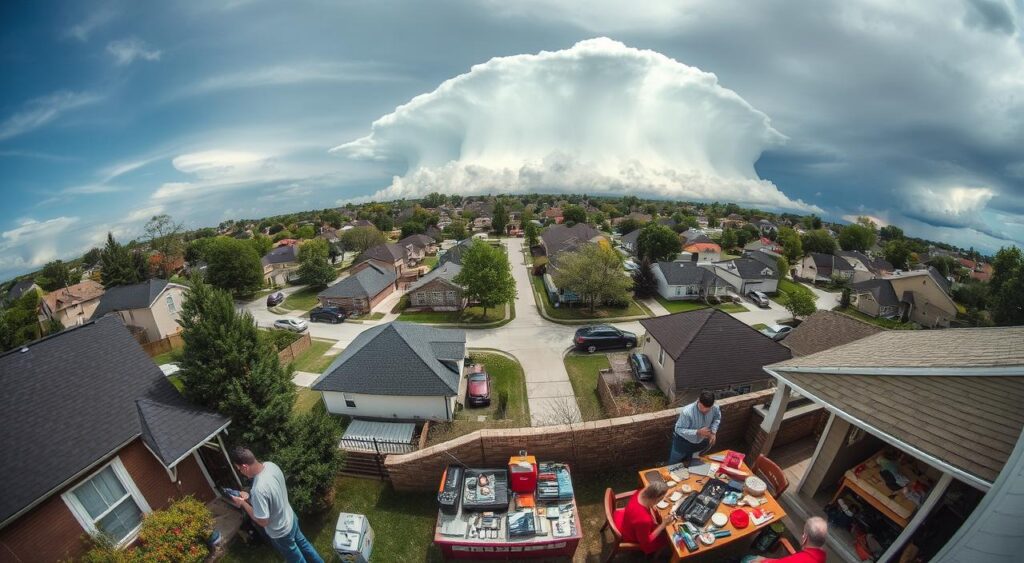
What Is a Tornado Warning?
A tornado warning is a serious alert. It means a tornado has been seen or detected by radar. This alert warns of an immediate danger and requires quick action. When a tornado warning is issued, you might hear sirens, showing it’s time to find shelter.
Definition and Purpose
The main goal of a tornado warning is to tell you a tornado is coming. It’s different from a tornado watch, which means a tornado might happen. A warning means a tornado is happening or will happen soon. You have about 30 minutes to act.
When Is a Warning Issued?
The National Weather Service issues tornado warnings when a tornado is spotted or detected by radar. These warnings are for specific places where a tornado is a big risk. The U.S. gets about 1,000 tornado warnings every year, mostly in the spring.
Immediate Actions to Take During a Tornado Warning
When a tornado warning is issued, you must act fast. Here are some steps to take:
- Find a sturdy building to hide in, like a basement or a small room on the lowest floor.
- Avoid windows and doors to stay safe from flying debris.
- If you’re outside, find a low spot to lie flat and cover your head. Avoid overpasses and bridges.
- Listen to emergency weather alerts on a radio or mobile device for updates.
The Role of the National Weather Service
The National Weather Service (NWS) plays a crucial role in the storm warning system. They work hard to watch and alert for severe weather, like tornadoes. With advanced tech and a team of meteorologists, they do detailed tornado risk assessments.
When a tornado might happen, the NWS quickly sends out watches and warnings. These alerts help people know what’s coming and get ready. The NWS’s quick and accurate alerts are key to keeping people safe during bad weather.
The NWS also uses data from Doppler radar and satellites to track storms in real-time. This method improves their tornado risk assessments. It helps them create a strong plan to lessen the effects of severe weather on people everywhere.
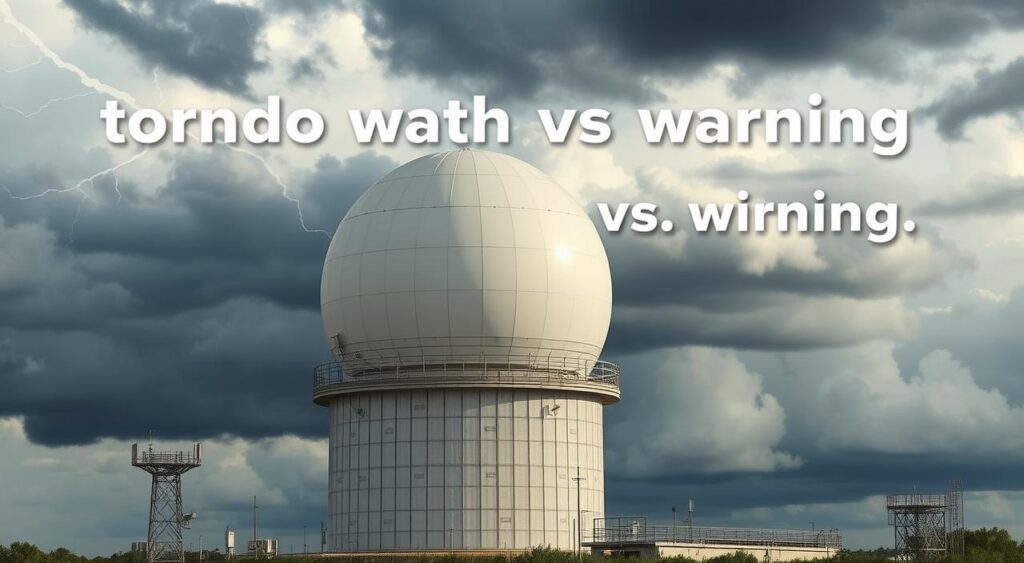
How Tornado Watches and Warnings Are Issued
Tornado watches and warnings are key parts of emergency weather alerts. They help keep you updated on severe weather. The Storm Prediction Center and local National Weather Service (NWS) offices do detailed analysis. They look at humidity and radar to see if a tornado might form.
A tornado watch means conditions are right for tornadoes, but none have been seen yet. It covers a big area, warning many counties. On the other hand, a tornado warning is urgent. It says a tornado is happening or will soon. This warning comes from radar or people who see it happening.
The average time you have to react to a tornado warning is 13 minutes. But, tornadoes can pop up fast, sometimes in just 10 minutes. The U.S. sees about 1,000 tornado watches every year. This shows how important it is to be ready for tornadoes.
While watches mean there’s a higher risk, warnings mean you need to act fast. Tornado warnings cover small areas. This makes it clear you should find a safe place right away.
| Type | Definition | Area Covered | Lead Time |
|---|---|---|---|
| Tornado Watch | Conditions are favorable for tornado formation. | Larger area, affecting multiple counties. | Varies, may give several hours’ notice. |
| Tornado Warning | Tornado is occurring or imminent. | Localized area, typically covering a smaller region. | Average of 13 minutes, can be longer. |
Knowing how tornado watches and warnings are issued helps you prepare for severe weather. It keeps you and your family safe.
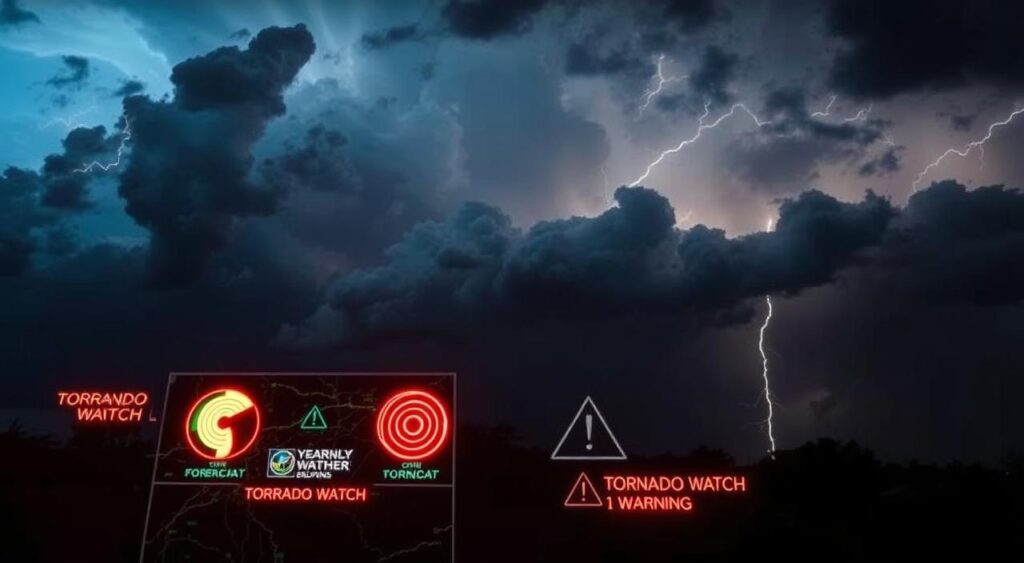
Tornado Emergency: The Highest Alert Level
A tornado emergency is the highest alert from the National Weather Service. It means a tornado is on the ground and is very dangerous. It’s a call for immediate action from everyone in the area. Knowing about tornado emergencies is key to staying safe during severe weather.
The first tornado emergency was in Oklahoma City on May 3, 1999. Since then, there have been 296 such alerts. In 2024, there were 6 tornado emergencies in the U.S. An emergency is declared when a tornado is confirmed by radar or reports, especially if it’s an EF3 or higher.
When a tornado emergency is declared, you need to find shelter right away. These alerts come with updates and instructions to keep you informed. For example, the Super Outbreak on April 27, 2011, had 16 emergency alerts. It shows how dangerous these storms can be.
Tornado emergencies happen fast and are very dangerous. The one in Hendersonville, Tennessee, in December 2023 was tragic, with three deaths. It highlights the importance of being ready and acting quickly when you get an alert.
Being alert to severe weather alerts and understanding tornado emergencies can save lives. Here are some key statistics:
| Year | Tornado Emergencies Issued |
|---|---|
| 2023 | 15 |
| 2024 | 6 |
| Total since 1999 | 296 |
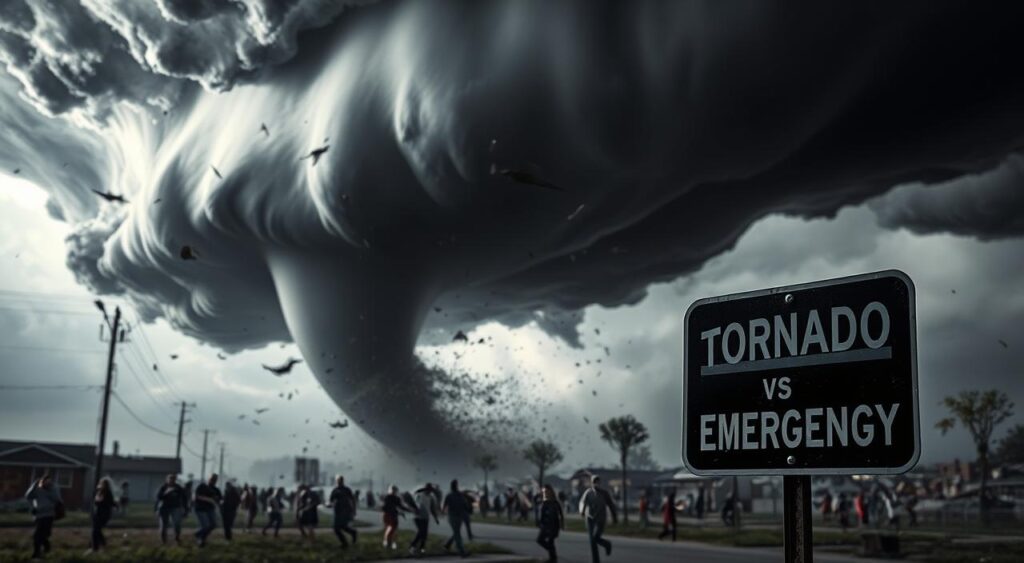
Understanding Weather Advisories
Knowing about weather advisories is key to being ready for weather. These advisories tell you about less severe weather that can still affect safety and daily life. By knowing about different emergency weather alerts, you can prepare and take action.
Types of Weather Advisories
Weather advisories include several alerts, such as:
- Winter Weather Advisory: Warns of snow or ice that might cause trouble.
- Flood Advisory: Tells you about possible flooding, especially during heavy rain.
- High Wind Advisory: Alerts you to strong winds that could be dangerous outside.
- Heat Advisory: Urges caution during very hot weather.
These advisories are not as severe as watches and warnings. They mainly aim to keep you informed and prepared for weather changes.
How to Stay Informed on Weather Updates
It’s important to stay updated on weather alerts for your safety. Here are some ways to do so:
- Listen to local radio or watch news for weather updates.
- Use weather apps or websites for real-time alerts.
- Sign up for local alert systems to get notifications on your device.
- Follow meteorological organizations on social media for updates.
By understanding weather advisories and keeping an eye on emergency weather alerts, you can better prepare for weather events.
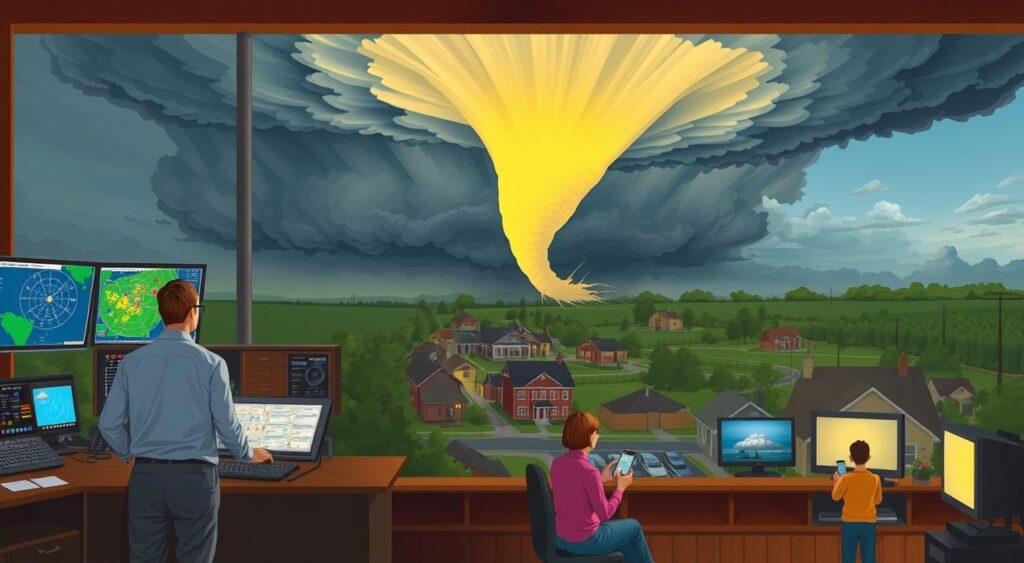
Tornado Preparedness and Safety Tips
Knowing how to prepare for tornadoes is key to keeping your family safe. Having a plan and a disaster kit can greatly lower risks. Learning what to do in a tornado helps everyone stay calm and safe.
Creating an Emergency Plan
Make sure you have safe places in your home, like a basement or a room without windows. Teach all family members where these spots are. It’s also important to have a plan for staying in touch if you get separated.
Practice your plan often. Knowing your roles and responsibilities is crucial. Doing tornado drills yearly helps your family react quickly when danger strikes.
Building a Disaster Supply Kit
Every household should have a Go-Kit for 3 days and a Stay-at-Home Kit for 2 weeks. Your kit should have water, food, a flashlight, batteries, a first aid kit, and any needed medicines. Don’t forget important documents, cash, and a power source for medical devices. These items are vital for emergencies.
By following these tips, you’ll be ready for severe weather. Being prepared with the right knowledge protects your family when it counts.
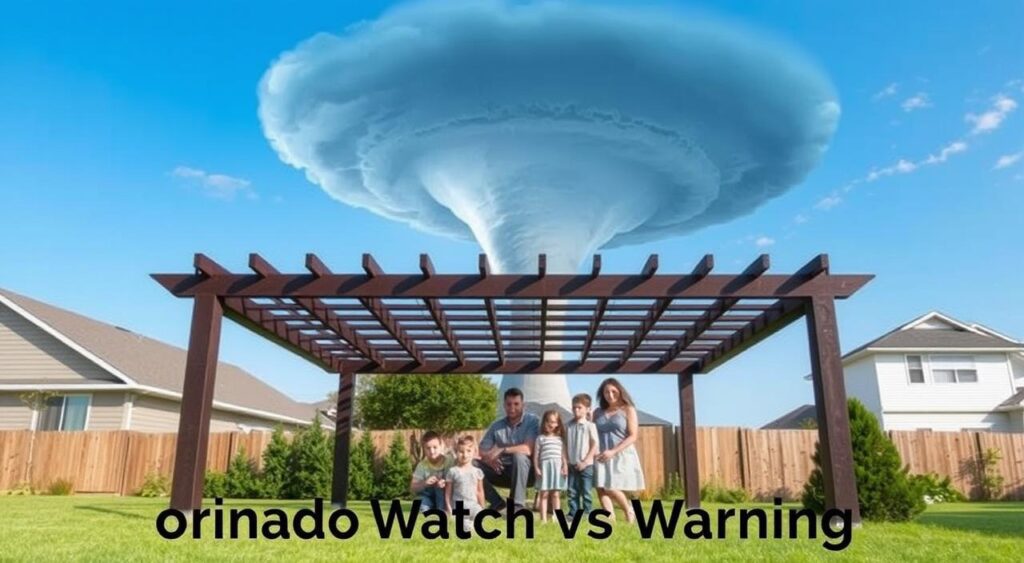
Assessing Tornado Risk
Knowing your tornado risk is key to being ready. Look at past tornadoes in your area. Think about your local geography and when tornadoes are most likely. The Storm Prediction Center (SPC) has great tools to help you understand severe weather risks in the US.
The SPC gives forecasts and watches for severe storms and tornadoes. Severe thunderstorms can cause damage with strong winds or hail. Tornadoes from these storms can be very destructive. Keeping up with local resources helps you stay ready for severe weather.
Understanding SPC’s forecast levels can help you assess your risk. They range from general thunderstorms to severe weather outbreaks. These alerts give you the info you need to prepare for tornadoes.
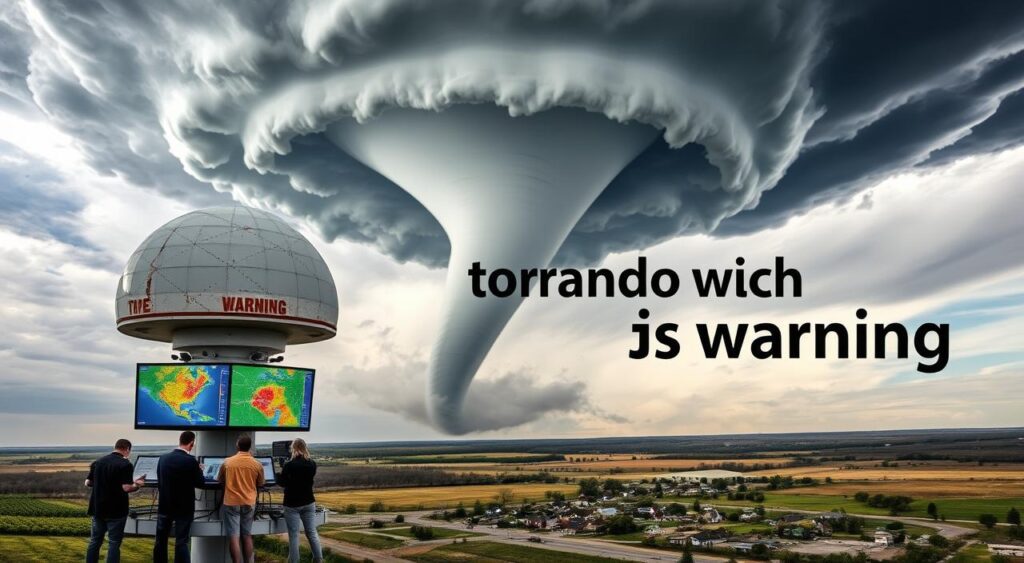
Creating an emergency plan and watching local alerts can lower your risk. During a tornado watch, watch for thunderstorms and severe weather. Having a safety plan in place makes you more ready for tornadoes.
Monitoring Severe Weather
Learning how meteorologists predict tornadoes is key to staying safe. They use high-tech tools and study the weather closely. They watch moisture, wind, and storms to send out timely warnings.
How Meteorologists Predict Tornadoes
Meteorologists use many models to guess when tornadoes might happen. They look at important weather data, like:
- Moisture levels in the air, which can affect storms.
- Cold fronts to track weather changes.
- Radar data to see where storms and tornadoes might form.
Tornado watches cover big areas and come hours before a storm. They help people get ready. Tornado warnings, on the other hand, are for smaller areas and mean you need to act fast.
The National Oceanic and Atmospheric Administration’s Storm Prediction Center (SPC) is key in tracking severe weather. They forecast up to eight days ahead and give daily updates. They use a 1-5 scale to show how severe storms are, with 5 being the most dangerous.
Working together, the National Severe Storms Laboratory (NSSL) and SPC improve forecasting. They use many models at once and detailed thunderstorm models. This helps you get ready for tornadoes.
Meteorologists keep working to make their predictions better. They aim to send out warnings quickly and accurately. This helps keep people safe from severe weather.
Conclusion
Knowing the difference between a tornado watch and warning is key to staying safe. A watch means conditions are right for a tornado, lasting 4 to 8 hours. A warning means a tornado has been spotted or detected, lasting about 30 minutes. These alerts are crucial for quick action in dangerous weather.
Being ready and informed is vital during tornado season. Keep up with weather updates, have a safety plan, and a disaster kit. If a warning comes, find shelter fast, especially if you’re in a mobile home.
Understanding severe weather alerts helps you stay safe. Start by knowing the difference between a watch and warning. Then, take steps to protect yourself and others.
FAQ
What is the main difference between a tornado watch and a tornado warning?
A tornado watch means conditions are right for tornadoes to form. It tells you to stay alert. A tornado warning means a tornado has been spotted or is on radar. You need to act fast.
How can I stay safe during a tornado watch?
During a tornado watch, keep an eye on local weather updates. Make sure you have an emergency plan ready. Also, have a disaster supply kit ready in case things get worse.
What should I do if a tornado warning is issued?
If a tornado warning is issued, find a safe place to hide right away. This could be a basement or an interior room without windows. Keep listening to local news for more updates and safety tips.
How do local authorities issue tornado watches and warnings?
Tornado watches and warnings are given by the National Weather Service. They analyze the weather, including humidity and storm systems, to decide.
What does a tornado emergency indicate?
A tornado emergency is the highest alert. It means a very dangerous tornado is on the ground. You need to act fast to stay safe.
What types of weather advisories should I be aware of?
Weather advisories warn about high winds, flooding, or winter weather. These conditions might not be as dangerous as watches and warnings. But, they still need your attention and preparation.
How can I effectively prepare for a tornado?
To get ready for a tornado, make an emergency plan. It should include where to go for safety and how to communicate. Also, review and practice the plan with your family regularly.
What resources can help me assess my tornado risk?
Knowing about past tornadoes, your area’s geography, and seasonal patterns helps you understand your risk. Keep up with local resources and alerts to stay informed.
What technology do meteorologists use to predict tornadoes?
Meteorologists use advanced tools like radar, moisture analysis, and storm forecasting models. These help them predict tornadoes and alert the public through emergency messages.
Share this content:
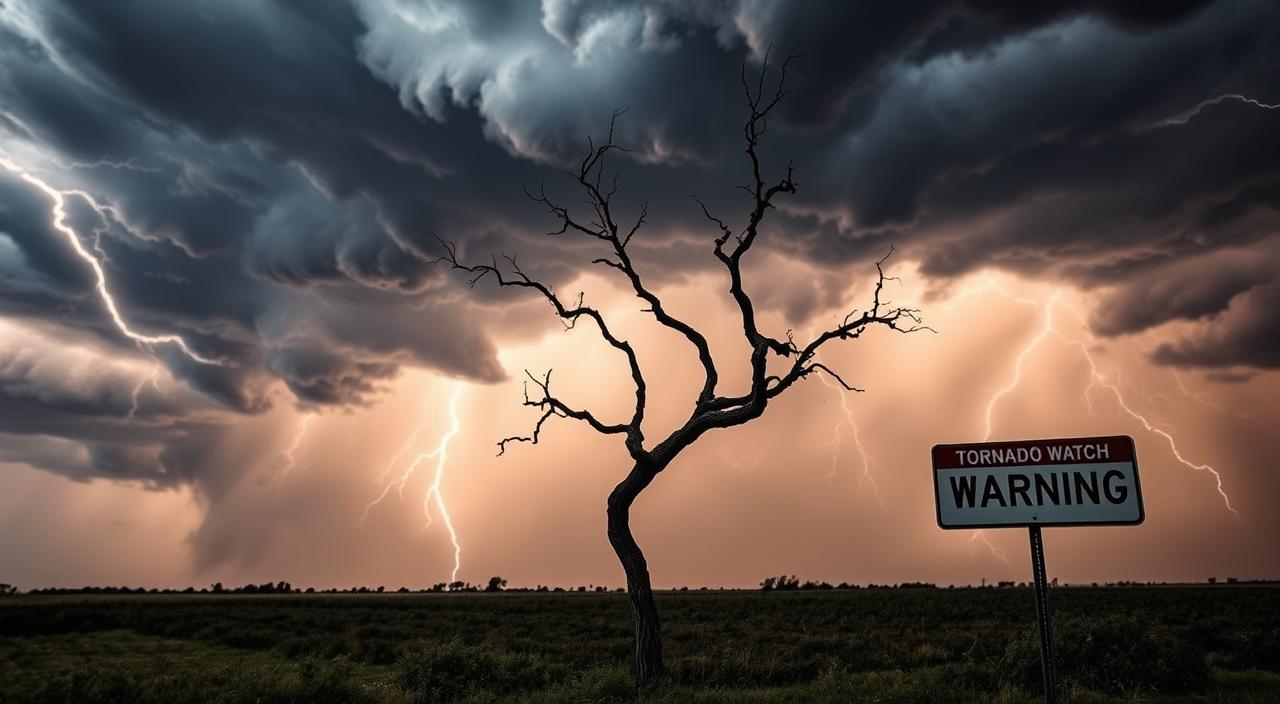
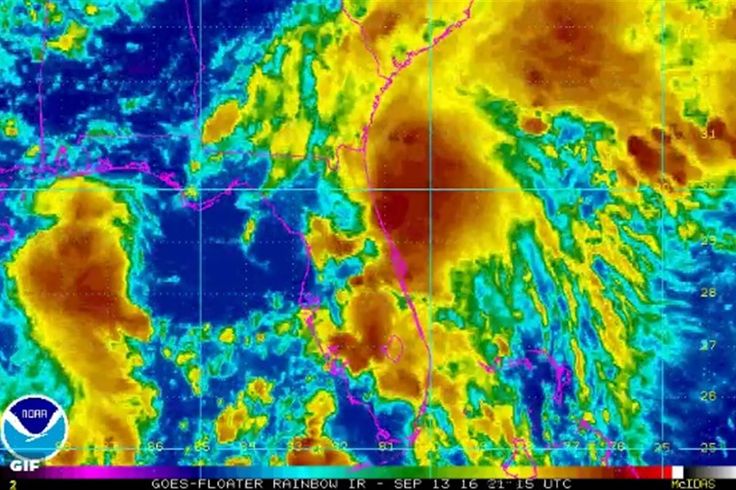


Post Comment